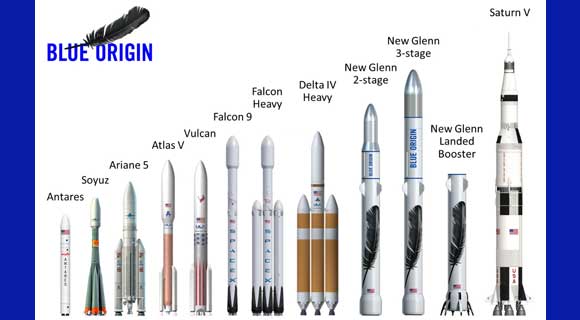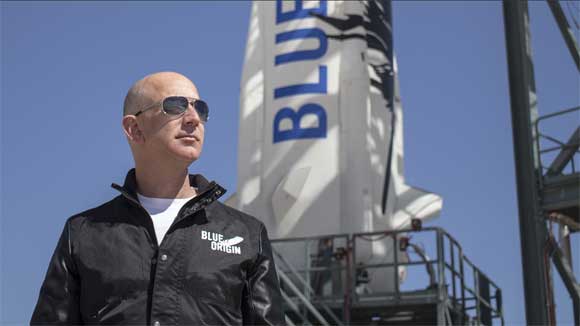Jeff Bezos Reveals Blue Origin’s ‘New Glenn’ Huge Rocket For Satellite, Crew Launches
By Space Coast Daily // September 12, 2016
rocket will fly before the end of the decade

Blue Origin founder Jeff Bezos announced Monday his company’s new reusable rocket called “New Glenn,” which will launch satellites as well as astronauts into space.
The rocket is named in honor of John Glenn, the first American to orbit Earth after blasting off from Cape Canaveral in 1962.
The New Glenn is projected to be more powerful than both SpaceX’s future Falcon Heavy rocket and the United Launch Alliance’s Delta IV Heavy.
According to Bezos in an e-mail, the two-stage variant of New Glenn will measure 23-feet in diameter and stand 270 feet tall, with a sea-level thrust of 3.85 million pounds.
The engines will burn liquefied natural gas and liquefied oxygen. The three-stage variant of New Glenn will be 313 feet tall, with a single BE-3 engine powering its upper stage.
“New Glenn is designed to launch commercial satellites and to fly humans into space,” Bezos wrote in the e-mail.
“The three-stage variant—with its high specific impulse hydrogen upper stage—is capable of flying demanding beyond-LEO missions.”
Blue Origin, which is in the midst of building launch and production facilities at Cape Canaveral, Florida, plans to fly New Glenn for the first time by the end of this decade.
The new rocket and its engines, like the smaller BE-3 and New Shepard Propulsion module upon which it is based, will be reusable. The first stage of the booster is being designed to fly a minimum of 25 missions.
This does not seem an idle boast, either, as Blue Origin has already flown and landed a single New Shepard rocket four times.
“The 3-stage variant – with its high specific impulse hydrogen upper stage – is capable of flying demanding beyond-LEO missions,” he said.
“Our vision is millions of people living and working in space, and New Glenn is a very important step. It won’t be the last of course,” Bezos said.
“Up next on our drawing board: New Armstrong. But that’s a story for the future.”
CLICK HERE FOR NASA AND SPACE NEWS














